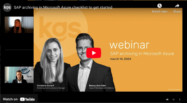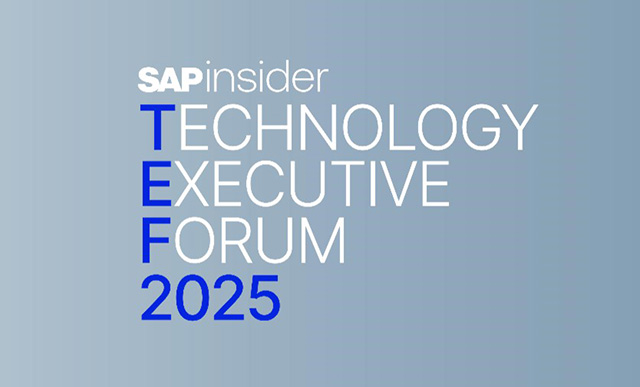SAP Cloud Providers
Filter By
Browse By
- SAP Analytics and AI
- SAP Application Development and Integration
- All SAP Application Development and Integration
- SAP ABAP
- SAP ABAP Development Tools
- SAP ABAP Test Cockpit
- SAP API Management
- SAP BAPI
- SAP Basis
- SAP BRF
- SAP Business Application Studio
- SAP CMS
- SAP Design Studio
- SAP Development Tools
- SAP DevOps
- SAP EAI
- SAP EDI
- SAP Extension Suite
- SAP Fiori
- SAP Fiori Elements
- SAP Integration Suite
- SAP Low Code Application Development
- SAP Low Code Automation
- SAP Netweaver
- SAP Release Management
- SAP UI5
- SAP Web Application Server
- SAP Web IDE
- SAP Business Process Management
- SAP Center of Excellence
- SAP CIO
- SAP Customer Experience
- SAP Data and Data Management
- All SAP Data and Data Management
- SAP BW
- SAP BW/4HANA
- SAP Crystal Reports
- SAP Data Archiving
- SAP Data Center
- SAP Data Governance
- SAP Data Integration
- SAP Data Migration
- SAP Data Quality
- SAP Data Services
- SAP Data Strategy
- SAP Data Visualization
- SAP Data Warehouse Cloud
- SAP DMS
- SAP Document Control
- SAP EIM
- SAP ETL
- SAP ETL Tools
- SAP HANA
- SAP HANA Administration
- SAP HANA Deployment Infrastructure
- SAP HANA Studio
- SAP Master Data
- SAP Master Data Governance
- SAP MDM
- SAP Enterprise Architect
- SAP Enterprise Asset Management
- SAP ERP
- SAP Finance
- All SAP Finance
- SAP Accounting
- SAP AR AP
- SAP Asset Accounting
- SAP Billing Systems
- SAP BPC
- SAP BRIM
- SAP Cash Management
- SAP Central Finance
- SAP Controlling
- SAP COPA
- SAP Cost Center Accounting
- SAP Currency Risk
- SAP e-invoicing
- SAP FICO
- SAP Finance Automation
- SAP Advanced Financial Closing
- SAP Financial Consolidation
- SAP Financial Planning
- SAP FX Risk
- SAP General Ledger
- SAP Global Tax Management
- SAP Hyperion
- SAP Order to Cash
- SAP Payment Processing
- SAP Profitability Analysis
- SAP Rebate Management
- SAP S/4HANA Finance
- SAP SWIFT Compliance
- SAP Treasury Management
- SAP Universal Journal
- SAP Governance Risk and Compliance
- SAP Human Capital Management
- SAP Intelligent Technologies
- SAP Platform and Technology
- All SAP Platform and Technology
- SAP Business Technology Platform
- SAP Cloud
- SAP Cloud Connector
- SAP Cloud Integration Platform
- SAP Cloud Migration
- SAP Cloud Platform
- SAP Cloud Providers
- SAP Cloud Strategy
- SAP Digital Signature
- SAP Container Platform
- SAP HANA Enterprise Cloud
- SAP Digital Asset Management
- SAP Smart Forms
- SAP HEC
- SAP Digital Integration Hub
- SAP Hyperscalers
- SAP Infrastructure
- SAP Messaging
- SAP Quality and Testing
- SAP Security
- SAP Spend Management
- SAP Supply Chain Management
- All SAP Supply Chain Management
- SAP APO
- SAP Asset Management
- SAP Business Network
- SAP Digital Manufacturing Cloud
- SAP Digital Twin
- SAP EWM
- SAP IBP
- SAP Inventory Management
- SAP Label Printing
- SAP Logistics
- SAP Manufacturing
- SAP Manufacturing Automation
- SAP MES
- SAP MII
- SAP MM
- SAP MRO
- SAP MRP
- SAP Order Management
- SAP Plant Maintenance
- SAP PLM
- SAP Production Planning
- SAP S&OP
- SAP SD
- SAP SPM
- SAP Supply Chain Planning
- SAP Track and Trace
- SAP Transportation Management
- SAP System Administration
SAP Cloud Providers: An Overview and Key Considerations
What are SAP Cloud Providers?
For those moving SAP workloads to the cloud, there are multiple choices available in terms of where those solutions and their associated data repositories are located. For years organizations have been using hosting partners or managed service providers for infrastructure, though these are now referred to as private cloud environments.
At the other end of the spectrum are the SAP Hyperscalers (link to landing page) or what are called public cloud providers. These large organizations often have software or data from multiple customers running on the same hardware or systems in different virtual environments, called multi-tenant public cloud. These public cloud providers can also offer single-tenant public cloud environments where they ensure that software and data from only one organization is present on any given infrastructure.
SAP Cloud Providers: An Overview and Key Considerations
What are SAP Cloud Providers?
For those moving SAP workloads to the cloud, there are multiple choices available in terms of where those solutions and their associated data repositories are located. For years organizations have been using hosting partners or managed service providers for infrastructure, though these are now referred to as private cloud environments.
At the other end of the spectrum are the SAP Hyperscalers (link to landing page) or what are called public cloud providers. These large organizations often have software or data from multiple customers running on the same hardware or systems in different virtual environments, called multi-tenant public cloud. These public cloud providers can also offer single-tenant public cloud environments where they ensure that software and data from only one organization is present on any given infrastructure.
Other environments considered to be SAP Cloud Providers include larger managed service providers that offer their own hosting services in combination with infrastructure from larger public cloud providers. Some examples of these providers working in the SAP space include, but are not limited to:
The last type of SAP Cloud Provider is the managed environment on-premise offered by large technology companies. In these environments, organizations pay based on usage as they would with a public cloud or hyperscaler, but the hardware is physically located in their own data centers. Organizations offering these solutions for SAP are:
Key Considerations for SAPinsiders
- Ensure that you understand as much about your cloud service provider as you can before moving workloads. Every organization will want to understand how much it will cost them to start running workloads in the cloud, and how security can be assured on the data that they have located there. But there are other questions that you should also get answered before selecting a cloud service provider. This blog covers six basic questions that you should ask your cloud service provider before you start moving your SAP workloads and provides a starting point for making sure you know everything you need to know before making a commitment.
- Understand what sort of cloud environment you need and what best suits your requirements.There are many choices when it comes to cloud environments, including private cloud and public cloud, and a combination of these environments referred to as a hybrid landscape. Not every environment is suited for every deployment or every organization, and understanding the pros and cons of each choice is one of the most crucial parts of moving to the cloud. This article interviews multiple executives who made different choices when it came to cloud deployments in their own organizations, and why those made sense to them. Understanding these options is important to ensuring your own cloud success.
16 results
-

RISE with SAP’s New Hyperscaler Option is IBM
Reading time: 4 mins
RISE with SAP on IBM Power Virtual Server is now available, offering a familiar cloud migration path for existing SAP S/4HANA users and those on older SAP ERP systems, allowing for a streamlined transition to SAP Cloud ERP that enhances reliability and reduces complexity while leveraging IBM’s infrastructure.
-

SAP Archiving in Microsoft Azure Checklist to Get Started
SAP and Microsoft are increasingly dancing around the room together. But hold on: the big move to the Azure cloud is often brought to a standstill by the many stumbling blocks of the small peripheral systems. What do you need to bear in mind to archive from SAP to Azure with ease?
-

JB Cocoa Enabling Traceability to Achieve ESG Commitments
Reading time: 5 mins
JB Cocoa breaks down data silos by deploying SAP on Google Cloud to monitor group performance with real-time data, while improving traceability of cocoa beans to meet customer sustainability targets.
-
-

Leveraging SAP’s Transformation Suite approach with LeanIX, SAP Signavio, and SAP Cloud ALM
Join us for a valuable pre-conference session covering the interplay of LeanIX, Signavio, and SAP Cloud ALM. This engaging session will empower enterprise architects and Centers of Excellence (COEs) with innovative and efficient strategies to lead transformation initiatives. Attendees will gain the insights to navigate modern transformation complexities confidently and flexibly. You will: Demystify the...…
-

Modernize your SAP landscape with Red Hat and Intel
Reading time: 1 min
Organizations are digitally transforming to take advantage of growth opportunities in new markets, adapt to evolving customer behaviors and preferences, and combat increased competitive pressure. As a result, modernizing infrastructure with increased agility, flexibility, manageability, and security is a top long-term goal for 49% of organizations. Technologies like containers, microservices, and cloud infrastructure support these…
-

- SAP Cloud Providers
 Premium
Premium
Build a modern data estate with Microsoft Azure and SAP
In this session, SAP and MSFT experts will share how customers can unlock insights from their SAP data using SAP and Azure analytics solutions. Join us to learn about: - How to use Azure data and analytics services to drive improved business outcomes - How to drive business transformation using SAP Business Solutions - The…
-

Rely on Google Cloud for SAP, today and tomorrow
Reading time: 1 min
In this solution brief, learn how deploying SAP on Google Cloud will reduce risk, increase agility and drive innovation for your organization. Find more insightful content from Google Cloud on their Vendor Showcase.
-
-

- SAP Cloud Providers
 Premium
Premium
Top 10 Considerations for Your SAP Deployment in Public Cloud
Reading time: 7 mins
Many SAP customers have had mission critical SAP applications running on-premise for years. These SAP applications support business processes related to finance, supply chain, and human resources, making the availability of these applications is critical to successfully run a business. There are also data privacy requirements that must be met. Oftentimes these SAP systems are…
-

SAP S/4HANA and Microsoft Azure
Reading time: 5 mins
On October 21, 2019, SAP announced Microsoft Azure as the key cloud platform for SAP S/4HANA. Building on the “Embrace” project SAP announced at SAPPHIRE NOW in May 2019, this new cloud partnership between SAP and Microsoft focuses on creating industry-specific bundles to simplify migration to SAP S/4HANA on Azure, creating a joint sales and…
-

SAP Announces Microsoft Azure as Key Cloud Platform for SAP S/4HANA
Reading time: 6 mins
Today’s SAP Q3 2019 earnings call went way beyond announcing double-digit year over year revenue growth and a 37% boost in cloud revenue, as it also unveiled a new strategic partnership with Microsoft that emphasizes Microsoft Azure as the key cloud platform to support SAP S/4HANA, SAP’s flagship ERP release. Membership Required You must be…
Become a Member
Unlimited access to thousands of resources for SAP-specific expertise that can only be found here.
Become a Partner
Access exclusive SAP insights, expert marketing strategies, and high-value services including research reports, webinars, and buyers' guides, all designed to boost your campaign ROI by up to 50% within the SAP ecosystem.
Upcoming Events
-

SAPinsider Technology Executive Forum
December 02 - 03, 2025
Phoenix, Arizona
United States
View Event
Related Vendors
Your request has been successfully sent

